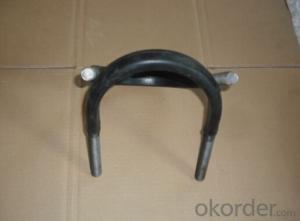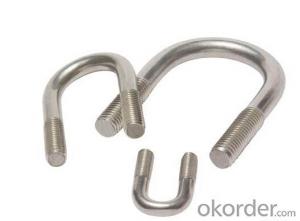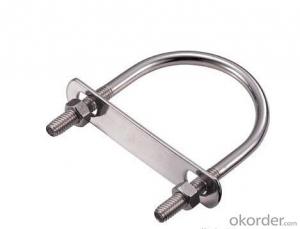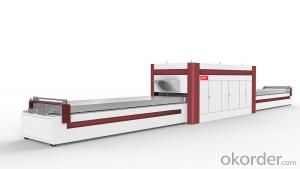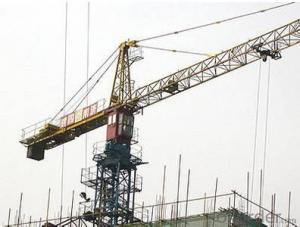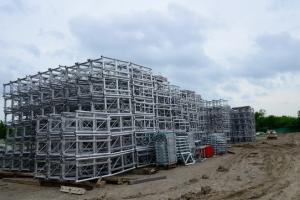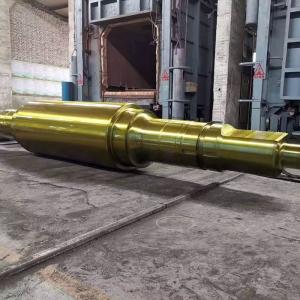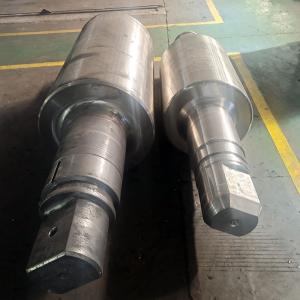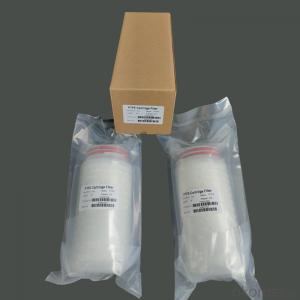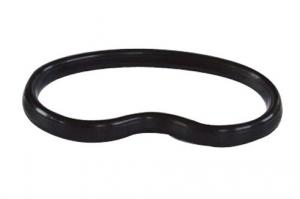U shape pipe clamp for SANY Concrete Pump with high quanlity
- Loading Port:
- Shanghai
- Payment Terms:
- TT OR LC
- Min Order Qty:
- 1 set
- Supply Capability:
- 1000 set/month
OKorder Service Pledge
OKorder Financial Service
You Might Also Like
Concrete pump pipe clamp is applicable to concrete pump pipe.Its belongs to concrete pump spare parts
U shape pipe clamp for SANY Concrete Pump with high quanlity
Specifications
stainless steel u bolt clamp steel pipe
1.Manufactur supply directly.
2.Size:M4-M48.etc
3.ISO,SGS.
4.Grade:201,304,316...
stainless steel u bolt clamp steel pipe
Size:stainless steel u-bolts
M6x16-50
M8x20-100
M10x20-100
M12x20-100
M14x30-100
M16x30-100
M18x40-100
M20x40-100
M22x50-100
M27x50-100
M30x50-100
M36x50-100
material:stainless steel
201
304 0Cr18Ni9 304L 00Cr19Ni10
321 0Cr18Ni9Ti 316 0Cr17Ni12Mo2
316L 00Cr17Ni14Mo2 310S 0Cr25Ni20
surface:bright
Tolerance: +/-0.015mm
Grade: 4.6 4.8 5.6 5.8 6.8,etc
DN125 Concrete Pump Clamp Coupling
Type-HD
| 1.5" clamp HD |
2" clamp HD |
| 3" clamp HD |
| 4" clamp HD |
| 3"clamp HD (adjustable) |
| 4"clamp HD (adjustable) |
| 2.5" clamp HD |
| 5" clamp HD |
| 5" clamp HD (adjustable) |
Type-Bolt& snap
Bolt Clamp 2" |
| Bolt Clamp 3" |
| Bolt Clamp 4" |
| Bolt Clamp 5" |
| Bolt Clamp 6" |
| Bolt Clamp Boom Bracket Type 5" |
| Two Bolts Boom Clamp 5" |
| Snap Clamp 2" |
| Snap Clamp 3" |
| Snap Clamp 4" |
| Snap Clamp 4.5" |
| Snap Clamp 5" |
| Snap Clamp 6" |
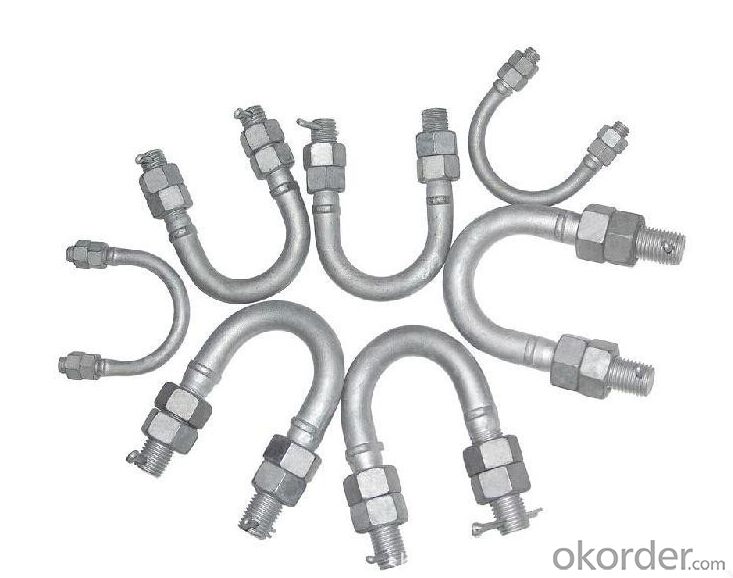
- Q:How often should I replace concrete pump spare parts?
- The frequency of replacing concrete pump spare parts depends on several factors such as the quality of the parts, the intensity of usage, and the maintenance practices. However, as a general guideline, it is recommended to inspect and replace worn or damaged concrete pump spare parts on a regular basis, typically every 6 to 12 months, to ensure optimal performance and avoid potential breakdowns or safety hazards.
- Q:Are there any warranties or guarantees available for concrete pump spare parts?
- Yes, there are warranties and guarantees available for concrete pump spare parts. Many manufacturers and suppliers offer warranties to ensure the quality and performance of their products. These warranties typically cover defects in materials or workmanship and provide a certain period of coverage, usually ranging from a few months to a year or more. Additionally, some suppliers may offer guarantees on the performance or durability of their spare parts, providing assurance and peace of mind to the customers. It is always recommended to inquire about the specific warranty or guarantee terms before purchasing concrete pump spare parts to ensure that you are protected in case of any issues.
- Q:What are the different types of concrete pump control system sensors?
- The different types of concrete pump control system sensors include pressure sensors, flow sensors, level sensors, temperature sensors, and proximity sensors.
- Q:How can one determine the correct voltage and current rating for electrical components in concrete pump spare parts?
- To determine the correct voltage and current rating for electrical components in concrete pump spare parts, one should refer to the manufacturer's specifications, which are typically provided in the product documentation or labeling. It is essential to match the voltage and current requirements of the electrical components to ensure proper functioning and prevent any potential damage or hazards.
- Q:What are the signs of a malfunctioning hydraulic oil cooler?
- There are various indications that may suggest a malfunctioning hydraulic oil cooler. 1. Overheating: The engine or hydraulic system experiencing overheating is one of the most common indications. If the hydraulic oil cooler is not functioning correctly, it may fail to adequately cool down the hydraulic fluid, resulting in elevated temperatures in the system. This can result in decreased performance, increased component wear and tear, and potential fluid breakdown. 2. Fluid Leaks: Another indication is the presence of hydraulic fluid leaks. Damaged or worn seals, gaskets, or hoses in a malfunctioning hydraulic oil cooler can cause these leaks. The leaks can be observable as fluid drips or puddles beneath the machinery or as oily residue on components. 3. Increased Noise: A malfunctioning hydraulic oil cooler can also cause heightened noise levels in the hydraulic system. This could be attributed to the introduction of air into the system, leading to cavitation or aeration. These abnormal noises can signal that the cooler is not functioning correctly and should be inspected or replaced. 4. Elevated Temperatures: Consistently higher-than-normal readings on the temperature gauge of your hydraulic system could indicate a malfunctioning oil cooler. The cooler may be unable to effectively dissipate heat from the hydraulic fluid, resulting in rising temperatures. This can lead to reduced efficiency, increased component wear, and potential system failures. 5. Reduced Performance: A malfunctioning hydraulic oil cooler can also result in reduced overall machinery or equipment performance. This can manifest as slower operation, decreased power output, or diminished hydraulic system response. If you observe a decrease in performance, it is advisable to inspect the oil cooler for any issues. Promptly addressing any of these indications is crucial. Continuing to operate machinery with a malfunctioning hydraulic oil cooler can cause further damage, increased downtime, and potentially expensive repairs. It is recommended to consult with a qualified technician or hydraulic specialist to diagnose and resolve any problems with the oil cooler.
- Q:How often should concrete pump lubrication systems be inspected and maintained?
- To ensure proper functioning and longevity, it is essential to regularly inspect and maintain concrete pump lubrication systems. The frequency of inspections and maintenance will vary depending on factors such as the pump type, usage, and manufacturer's recommendations. Typically, it is advised to conduct monthly inspections and maintenance of concrete pump lubrication systems. This regularity allows for early detection of potential issues or wear and tear that may require attention. Furthermore, routine inspections help identify signs of lubricant degradation or contamination, which can affect the system's efficiency and performance. During the inspection, it is crucial to check for leaks, damaged or worn-out components, and ensure adequate greasing of all lubrication points. Additionally, the lubrication system should be cleaned to eliminate any accumulated debris or contaminants. Apart from monthly inspections, certain maintenance tasks should be carried out at regular intervals. These tasks may include lubricant and filter changes, belt and hose adjustments or replacements, and checking the system's pressure and flow to ensure proper operation. It is important to emphasize that the manufacturer's guidelines and recommendations must always be followed for inspecting and maintaining concrete pump lubrication systems. These guidelines may provide specific instructions based on the pump type and model, as well as any unique requirements. By regularly inspecting and maintaining concrete pump lubrication systems, optimal performance can be ensured, downtime can be minimized, and the lifespan of the systems can be extended.
- Q:How can one determine the correct hardness and durometer rating for rubber components in concrete pump spare parts?
- Determining the correct hardness and durometer rating for rubber components in concrete pump spare parts requires considering several factors. Firstly, it is important to understand the specific application requirements of the rubber components. Factors such as the pressure, temperature, and frequency of use should be taken into account. Next, it is essential to consider the compatibility of the rubber material with concrete and other chemicals that may come into contact with the components. Chemical resistance is crucial to ensure the durability and longevity of the rubber parts. Additionally, analyzing the expected load and stress on the rubber components is crucial. Considerations such as the weight of the concrete, the force applied during pumping, and the potential impact or abrasion should be evaluated. Furthermore, environmental conditions should be considered. Factors like exposure to sunlight, extreme temperatures, or harsh weather conditions can affect the performance and lifespan of rubber components. Another aspect to consider is the specific type of rubber material used. Different rubber compounds have varying hardness and durometer ratings. Consulting with rubber manufacturers or suppliers who specialize in concrete pump spare parts can provide valuable insights and recommendations based on their expertise and experience. Ultimately, determining the correct hardness and durometer rating for rubber components in concrete pump spare parts requires careful evaluation of the application requirements, compatibility, load and stress factors, environmental conditions, and expert advice.
- Q:How do I identify the specific spare parts I need for my concrete pump?
- To find the specific spare parts you require for your concrete pump, you can follow these guidelines: 1. Refer to the user manual: Begin by consulting the user manual provided by the manufacturer. This manual typically includes a comprehensive list of parts, along with their respective numbers and descriptions. It may also feature diagrams or illustrations to aid in identifying the necessary spare parts. 2. Get in touch with the manufacturer: Reach out to the manufacturer of your concrete pump. They possess the most accurate and up-to-date information regarding spare parts for your particular model. Provide them with the model number and any other relevant details to ensure precise identification of the required parts. 3. Connect with authorized dealers or distributors: If the manufacturer cannot directly provide you with the spare parts, they can often direct you to authorized dealers or distributors. These professionals specialize in concrete pump parts and can assist you in identifying the specific spare parts you need. Share the model number and any other pertinent details to aid them in locating the correct parts. 4. Capture images or dimensions: If you are unable to find the necessary information through the manual, manufacturer, or authorized dealers, you can take pictures or measurements of the damaged or worn-out parts. This will help visually identify the parts and provide accurate dimensions, which can be shared with suppliers or industry experts who may be able to offer further assistance. 5. Conduct online research: Utilize online resources such as parts catalogs, forums, or websites dedicated to concrete pump spare parts. These platforms often have extensive databases and knowledgeable communities that can help you identify the specific spare parts you require. Search for your concrete pump model and explore the available resources to find the relevant parts. Remember to prioritize quality and authenticity when purchasing spare parts for your concrete pump. It is crucial to buy from reputable sources to ensure the durability and longevity of your equipment.
- Q:How often should concrete pump hydraulic motors be inspected and replaced?
- Concrete pump hydraulic motors should be inspected regularly, ideally every 500 to 1000 hours of operation, to ensure they are in good working condition. However, the frequency of replacement depends on various factors such as usage intensity, maintenance practices, and the quality of the motor. Generally, hydraulic motors can last for several years if properly maintained, but if any signs of wear, leakage, or reduced performance are observed, it is recommended to replace them promptly to prevent potential breakdowns or accidents.
- Q:What are the signs of a malfunctioning lubrication system?
- There are several signs that can indicate a malfunctioning lubrication system. Firstly, if you notice any unusual noises coming from the engine, such as grinding or squealing, it could be a sign that the lubrication system is not properly lubricating the moving parts. Additionally, if you start to experience a decrease in engine performance or a loss of power, it could be due to insufficient lubrication. Another common sign is the presence of oil leaks, which can indicate a problem with the lubrication system seals or gaskets. If you notice a burning smell or smoke coming from the engine, it could be a sign of oil leaking onto hot engine components. Finally, monitoring the oil pressure gauge is essential, as a malfunctioning lubrication system can result in low oil pressure, which can lead to engine damage if not addressed promptly. Overall, it is important to pay attention to these signs and address any potential issues with the lubrication system to ensure the proper functioning and longevity of your engine.
1. Manufacturer Overview |
|
|---|---|
| Location | |
| Year Established | |
| Annual Output Value | |
| Main Markets | |
| Company Certifications | |
2. Manufacturer Certificates |
|
|---|---|
| a) Certification Name | |
| Range | |
| Reference | |
| Validity Period | |
3. Manufacturer Capability |
|
|---|---|
| a)Trade Capacity | |
| Nearest Port | |
| Export Percentage | |
| No.of Employees in Trade Department | |
| Language Spoken: | |
| b)Factory Information | |
| Factory Size: | |
| No. of Production Lines | |
| Contract Manufacturing | |
| Product Price Range | |
Send your message to us
U shape pipe clamp for SANY Concrete Pump with high quanlity
- Loading Port:
- Shanghai
- Payment Terms:
- TT OR LC
- Min Order Qty:
- 1 set
- Supply Capability:
- 1000 set/month
OKorder Service Pledge
OKorder Financial Service
Similar products
New products
Hot products
Related keywords
